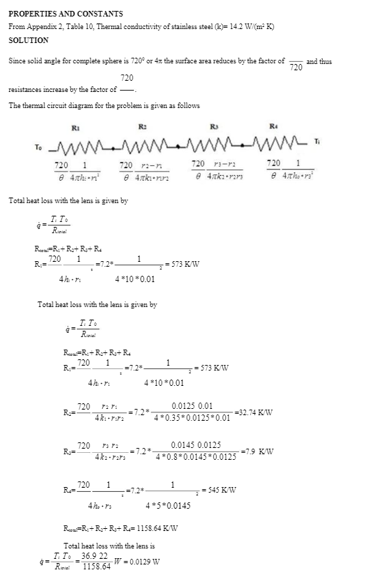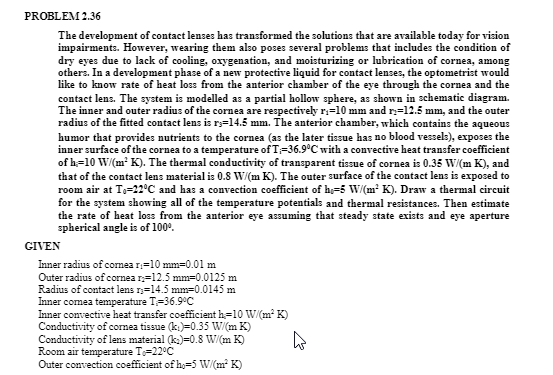Please comment about the solution
Principles of Heat Transfer (Activate Learning with these NEW titles from Engineering!)
8th Edition
ISBN:9781305387102
Author:Kreith, Frank; Manglik, Raj M.
Publisher:Kreith, Frank; Manglik, Raj M.
Chapter5: Analysis Of Convection Heat Transfer
Section: Chapter Questions
Problem 5.10P: 5.10 Experiments have been performed on the temperature distribution in a homogeneous long cylinder...
Related questions
Question
Principles Of Heat Transfer 8th edition, Problem 1.67chapter 1.
Please comment about the solution

Transcribed Image Text:PROPERTIES AND CONSTANTS
From Appendisx 2, Table 10, Thermal conductivity of stainles steel (k)= 142 W(m K)
SOLUTION
Since solid angle for complete sphere is 720° or 4z the sarface area reduces by the factor of
and thus
720
720
resistances increase by the factor of -.
The tharmal eircuit diagram for the problem is given as follows
RI
R:
720 1
720 ra-n
720 P-ra
720
1
e 4:th n
e 4th r
Total heat loss with the lans ia given by
T. T.
Ru-R+Re+ R+ R.
1
R.20 1
573 KW
4*10 *0.01
Total heat los with the lens is given by
T.T.
Roe
R-R+R+ R+ R.
720 1
R
1
-7.2
- 573 KW
4"10 *0.01
720 ra
0.0125 0.01
-7.2
32.14 KW
4"0.35*0.0125 0.01
720
R
0.0145 0.0125
7.2
--79 KW
4"0.8"0.0145 "0.0125
720
1
-7.2
1
545 KW
4*5*0.0145
Ru-R+R+R+ R-1158.64 KW
Total heat loss with the lens is
T. T. 36.9 22
Re 1158.64
-W-0.0129 W

Transcribed Image Text:PROBLEM 2.36
The development of contact lenses has transformed the solutions that are available today for vision
impairments. However, wearing them also poses several problems that includes the condition of
dry eyes due to lack of cooling, oxygenation, and moisturizing or lubrication of cornea, among
others. In a development phase of a new protective liquid for contact lenses, the optometrist would
like to know rate of heat loss from the anterior chamber of the eye through the cornea and the
contact lens. The system is modelled as a partial hollow sphere, as shown in schematic diagram.
The inner and outer radius of the cornea are respectively r;=10 mm and r=12.5 mm, and the outer
radius of the fitted contact lens is ry=14.5 mm. The anterior chamber, which contains the aqueous
humor that provides nutrients to the cornea (as the later tissue has no blood vessel:), exposes the
inner surface of the cornea to a temperature of T=36.9°C with a convective heat transfer coefficient
of h=10 W/(m² K). The thermal conductivity of transparent tissue of cornea is 0.35 W/(m K), and
that of the contact lens material is 0.8 W/(m K). The outer surface of the contact lens is exposed to
room air at T,-22°C and has a convection coefficient of h=5 W/(m² K). Draw a thermal circuit
for the system showing all of the temperature potentials and thermal resistances. Then estimate
the rate of heat loss from the anterior eye assuming that steady state exists and eye aperture
spherical angle is of 100°.
GIVEN
Inner radius of comea r=10 mm=0.01 m
Outer radius of cornea n=12.5 mm=0.0125 m
Radius of contact lens r;=14.5 mm=0.0145 m
Inner comea temperature T-36.9°C
Inner convective heat transfer coefficient h=10 W/(m K)
Conductivity of cornea tissue (k.)=0.35 W/(m K)
Conductivity of lens material (k.)=0.8 W/(m K)
Room air temperature Te=22°C
Outer convection coefficient of h,=5 W/(m K)
Expert Solution
This question has been solved!
Explore an expertly crafted, step-by-step solution for a thorough understanding of key concepts.
This is a popular solution!
Trending now
This is a popular solution!
Step by step
Solved in 2 steps

Knowledge Booster
Learn more about
Need a deep-dive on the concept behind this application? Look no further. Learn more about this topic, mechanical-engineering and related others by exploring similar questions and additional content below.Recommended textbooks for you

Principles of Heat Transfer (Activate Learning wi…
Mechanical Engineering
ISBN:
9781305387102
Author:
Kreith, Frank; Manglik, Raj M.
Publisher:
Cengage Learning

Principles of Heat Transfer (Activate Learning wi…
Mechanical Engineering
ISBN:
9781305387102
Author:
Kreith, Frank; Manglik, Raj M.
Publisher:
Cengage Learning